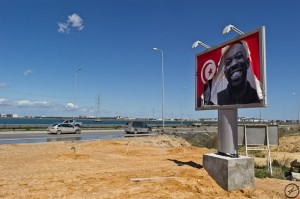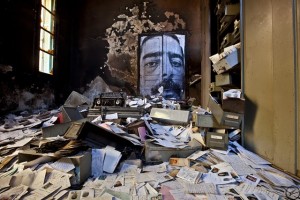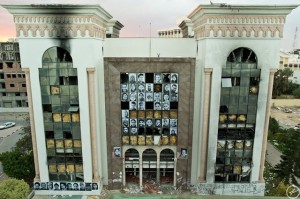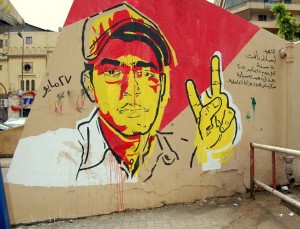The emergence of Photography 2.0 is itself now in process. Its “darkroom” is not in a studio but on the street. Its transitional form is so-called “street art,” aka graffiti. Like that precursor, street art may be just a transition to a marketable art form. For the time being, it helps think through the paradox that autonomy eludes representation.
In Tunisia, the French “artivist” (artist/activist) who calls himself JR realized a transformation of photography was happening. He organized an “inside out” visualization of the people as portrait photographs of random individuals, printed in poster size and posted as graffiti.
The project was called “artocracy.” This photographic commons turns hierarchy inside out and visualizes the present as prologue to a differently visualized future, rather than as the repetition of the past. Working in conjunction with Tunisian bloggers and using all local interlocutors and photographers, the goal was to create a series of one hundred portraits of people who had participated in the revolution.
The photographs were the large-scale head-and-shoulder closeups in black-and-white that have become JR’s signature style. Printed as 90x120cm posters, they were flyposted across four cities in Tunisia, including startling examples in the former secret police commissariat (below)
oron the façade of one of Ben Ali’s former houses (below).
Yet as the documentary posted on JR’s own website indicates, even this open access project was subject to intense criticism in Tunisia. “Why only a hundred?” was the common refrain. For the revolution is widely held to have been the work of the people, not a sub-set of heroes. No-one wants to replace autocracy with artocracy, even as a joke.
In Cairo, the contingency artist Ganzeer—his self-definition—who produced a widely-used PDF pamphlet on how to conduct a protest during the revolution, is now attempting the marathon project of street portraits of all 847 people who died in the revolution, the martyrs.
However, the Supreme Council of the Armed Forces, who are running Egypt, persist in painting over these memorials so Ganzeer, and his fellow street artists like Keizer and Sad Panda [more on them tomorrow] are using the Internet as an archive of their work. A Google maps mash-up indicates where and when the work was posted. Users are invited to “like” the link on Twitpic and Flickr but not Facebook, which is now too carefully under surveillance. Ganzeer had only accomplished three of these portraits as of last summer, making it unlikely that his martyrology will ever be accomplished.
The street art process centered on the individual, even when decentred and distributed, taken out of the gallery into the street, is not yet equal to the visualization of autonomy. I have argued that one person cannot convey the right to look: the interface between two or more people as they look at each other and allow the other to invent them even as they invent the other. In his essay that coined the phrase droit de regards, which I translate as “the right to look,” Jacques Derrida, the Algerian, insisted on precisely this incapacity of photography to convey the look into another’s eyes, whether literal or metaphorical. For the autocrat the answer is the same as it has ever been: “they cannot represent themselves: they must be represented.” So SCAF is as determined to push through a “representative” parliamentary democracy as it is to retain effective power.
The nub of the issue, then, is how, once autonomy has been claimed by the anonymous, they might visualize that autonomy as something that goes beyond transition. Street art has some components right–the value of the project is judged by the “street,” the anonymous. It perhaps overvalues the secrecy of its means of production as an end in itself–“how did s/he tag there?” is a great question under autocracy, less so as a means to autonomy. Its capacity to spontaneously generate new forms, however, is a striking way to think through how these issues are being worked out and worked over.
Continued tomorrow with the work of Sad Panda, Keizer and Ganzeer,




